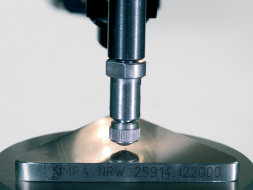Hardness
Mechanical hardness can be defined as the resistance of a body to an indentation of another harder body.

Hardness of materials is among the technologically most important material properties. Although hardness cannot be derived from the physical primary quantities, it is a measurable quantity that can be determined by various static and dynamic hardness testing methods. Hardness testing depends on a large number of different parameters, such as force, temperature, loading rate and time. Consequently, a detailed specification of the test method is necessary to compare numerical values. BEV realises the following three static hardness testing methods:
Its simple and quick applicability makes the Rockwell method one of the most widely used hardness testing methods in industrial practice, being standardised in DIN EN ISO 6508-1 to 3. In the Rockwell hardness test either a 120° diamond cone or a ball intender (steel or carbide) is used.
The indentation depth is the difference between the first indent with a preliminary test force and a second indent with a total test force. The calculated indentation depth is directly converted into a hardness number.
In the Vickers hardness test a diamond indenter, in the form of a square-based pyramid, serves as an indenter. It is pressed into the surface of the material with a prescribed test force leaving a rhombic indentation. The diagonal lengths of the indentation are measured with an integrated measuring microscope. The Vickers hardness test is carried out according to DIN EN ISO 6507-1 to 3 and is for instance suited for the examination of brittle hard materials and minerals.
In the Brinell hardness test a ball indenter made of hard metal (tungsten) with a specified diameter is pressed into the surface of the test piece using a predefined test force. The Brinell hardness value is proportional to the quotient resulting from the test force and the surface area of the indentation is. The direct relation between Brinell hardness and the tensile and breaking strength of various steel qualities makes this hardness testing method one of the most important in the field of non-destructive material testing. The Brinell hardness test is standardised in DIN EN ISO 6506-1 to 3.
Verification of standardised hardness reference blocks and diamond indenters

Hardness reference blocks and diamond indenters are subject to mandatory verification in Austria. In general all types are accepted for verification. Hardness reference blocks and diamond indenters are verified by the verification authority. Diamond indenters have a reverification interval of 4 years whereas hardness reference blocks are exempted from reverification.